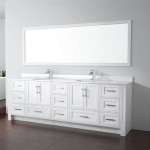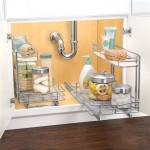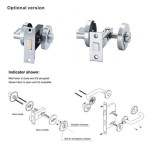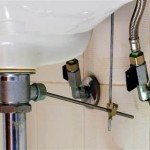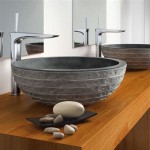Exposed Bathroom Vanity: Aesthetics, Functionality, and Considerations
An exposed bathroom vanity, characterized by its open design that reveals the plumbing and storage elements beneath the countertop, presents a compelling alternative to traditional enclosed units. This style, often associated with minimalist, industrial, and modern aesthetics, prioritizes visual lightness and can contribute to a feeling of spaciousness within the bathroom environment. However, the choice of an exposed vanity is not solely aesthetic; it involves a careful consideration of practical implications, including organization, maintenance, and the overall design cohesion of the bathroom.
The primary difference between an exposed vanity and a traditional enclosed vanity lies in the visibility of the under-sink area. Enclosed vanities conceal plumbing and offer built-in storage, often in the form of cabinets and drawers. Exposed vanities, conversely, allow these elements to be seen. This design choice inherently changes the visual dynamics of the bathroom, shifting the focus to the exposed pipework, support structures, and any storage solutions employed. As such, careful attention must be paid to the selection of these components to ensure they complement the desired aesthetic.
The increasing popularity of exposed vanities can be attributed to several factors. Modern design trends often emphasize simplicity and the incorporation of raw materials. The exposed vanity aligns with this philosophy, showcasing the functional aspects of the bathroom rather than concealing them. Furthermore, in smaller bathrooms, the visual openness of an exposed vanity can create the illusion of more space. The absence of bulky cabinets allows light to pass through more freely, contributing to a brighter and airier feel. Moreover, the minimalist aesthetic often associated with exposed vanities can impart a sense of serenity and order to the bathroom environment.
Aesthetic Considerations and Design Styles
The aesthetic impact of an exposed bathroom vanity is significant. Its open design makes it particularly well-suited for specific design styles, although its adaptability allows for integration into diverse bathroom aesthetics. The most commonly associated styles include:
Industrial: This style embraces raw materials, exposed brick, and utilitarian design. An exposed vanity with metal pipe supports and reclaimed wood shelving aligns perfectly with the industrial aesthetic, creating a bold and functional statement. The plumbing is often intentionally showcased, with copper or black iron pipes adding to the industrial character.
Minimalist: Minimalist design focuses on simplicity and clean lines. An exposed vanity in this style typically features a simple countertop, such as concrete or glass, supported by a minimal metal frame. Storage is often limited to open shelving, further emphasizing the minimalist ethos.
Modern: Modern design encompasses a broad range of styles, but it generally emphasizes clean lines, geometric shapes, and the use of modern materials. An exposed vanity in a modern bathroom might feature a sleek countertop, such as quartz or acrylic, paired with a minimalist metal or wooden frame. Careful attention is paid to the selection of fixtures and fittings to ensure they complement the overall modern aesthetic.
Rustic: While seemingly contradictory, exposed vanities can also be incorporated into rustic design schemes. In this context, the vanity often features a reclaimed wood countertop and a simple wooden frame. The exposed plumbing can be softened with natural materials and textures, such as woven baskets for storage.
Choosing the right materials is paramount to achieving the desired aesthetic. The countertop material sets the tone for the vanity, while the support structure and any accompanying shelves contribute to the overall design. For example, a concrete countertop paired with a black metal frame can create an industrial or modern look, while a butcher block countertop with a wooden frame can evoke a more rustic feel.
Furthermore, the choice of plumbing fixtures plays a crucial role in the aesthetic of an exposed vanity. Exposed pipes can be treated as a design element, with options ranging from polished chrome to brushed nickel to copper. The style of the faucet and sink should also complement the overall design scheme.
Functionality and Practical Considerations
While aesthetics are a primary consideration, the functionality of an exposed bathroom vanity is equally important. The open design necessitates careful planning and organization to ensure that the vanity remains visually appealing and practical for daily use. Key considerations include:
Storage: Traditional enclosed vanities offer ample built-in storage, while exposed vanities typically require alternative storage solutions. Open shelving is a common choice, allowing for easy access to frequently used items. However, open shelving can also contribute to visual clutter if not carefully organized. Baskets, bins, and decorative boxes can be used to contain smaller items and maintain a sense of order.
Organization: Effective organization is crucial for maintaining the visual appeal of an exposed vanity. Regularly decluttering and organizing the items stored beneath the sink is essential. Consider using clear containers to store toiletries and other small items, making it easier to find what you need and keeping the space tidy.
Plumbing: The exposed plumbing is a defining characteristic of this vanity style. It is essential to ensure that the plumbing is aesthetically pleasing and well-maintained. Consider using decorative pipe coverings or choosing plumbing fixtures with an attractive finish. Regularly cleaning the pipes will help prevent rust and corrosion, maintaining their appearance.
Maintenance: Exposed vanities require more frequent cleaning than enclosed vanities. Dust and debris can accumulate more easily in the open space beneath the sink. Regular cleaning with a damp cloth is necessary to keep the vanity looking its best. Additionally, it is important to promptly address any leaks or spills to prevent water damage and mold growth.
The placement of the vanity within the bathroom should also be considered. In smaller bathrooms, an exposed vanity can help create the illusion of more space. However, in larger bathrooms, an exposed vanity might feel too sparse or minimalist. Adding decorative elements, such as plants or artwork, can help to balance the visual weight of the vanity and create a more inviting atmosphere.
Installation and Cost Implications
The installation of an exposed bathroom vanity can be similar to that of a traditional enclosed vanity, but there are some key differences to consider. The cost can vary depending on the materials used, the complexity of the design, and whether professional installation is required.
Installation: The basic installation process involves securing the countertop to the support structure and connecting the plumbing. However, with an exposed vanity, more attention needs to be paid to the alignment and aesthetics of the plumbing. Professional installation is often recommended, particularly if the plumbing needs to be modified or if the homeowner is not comfortable working with plumbing.
Cost: The cost of an exposed vanity can range from relatively inexpensive to quite expensive, depending on the materials and design. A simple vanity with a basic countertop and metal frame can be relatively affordable, while a more elaborate vanity with a custom countertop and high-end plumbing fixtures can be significantly more expensive. Labor costs for installation should also be factored into the overall budget.
DIY Considerations: For homeowners with DIY experience, installing an exposed vanity can be a rewarding project. However, it is important to have a good understanding of plumbing and carpentry. Carefully measure and plan before starting the project, and ensure that you have all the necessary tools and materials. Always turn off the water supply before working on the plumbing.
Plumbing Modifications: Installing an exposed vanity might require modifications to the existing plumbing. This can involve rerouting pipes or installing new drain lines. It is essential to consult with a qualified plumber before making any major plumbing modifications to ensure that the work is done safely and according to code.
The choice of an exposed bathroom vanity involves a trade-off between aesthetics and functionality. While it can create a visually striking and spacious bathroom environment, it also requires careful planning, organization, and maintenance. By considering these factors, homeowners can make an informed decision and create a bathroom that is both beautiful and functional. The careful selection of materials, attention to detail in the installation process, and a commitment to organization are all essential for maximizing the benefits of an exposed bathroom vanity.

Photo 9 Of 18 In Modern Bathroom Vanity Ideas Dwell

Unexpected Beauty Exposed Plumbing Inview

Athena Modern Exposed Marble With Brushed Gold Freestanding Console Ba Sani

How To Know If An Open Bathroom Vanity Is For You

Furniture Vanities Design Considerations Kitchen Concepts

15 Examples Of Bathroom Vanities That Have Open Shelving

Simple Details Dresser As Bathroom Vanity

Vanities Furniture Style Vs Traditional Cabinet Toulmin Kitchen Bath Custom Cabinets Kitchens And Bathroom Design Remodeling In Tuscaloosa Birmingham Alabama

Athena Modern Exposed Marble With Brushed Gold Freestanding Console Ba Sani

Bathroom Storage Inspiration 6 Stunning White Oak Vanities Styled To Sparkle
Related Posts
